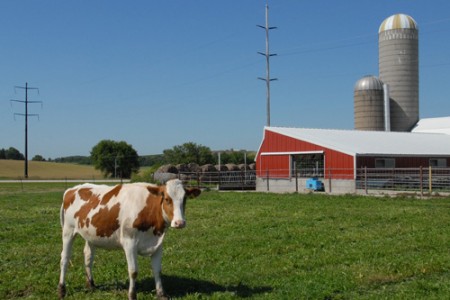Stray voltage
Stray voltage is the general term used to describe low-level voltages that may occur between surfaces that animals contact. On a farm, these surfaces may include stanchion pipes, water cups and feeders.
The term stray voltage is often used incorrectly to refer to other electrical phenomena such as electric fields, magnetic fields and most recently electric current flowing in the earth. These phenomena are generally referred to as electric and magnetic fields. Although stray voltage can’t be totally eliminated, it can be minimized.
Causes of stray voltage
Stray voltage is a naturally occurring phenomenon associated with on-farm wiring and electrical connections to utility distribution systems. Both farm systems and utility distribution systems are grounded to the earth to ensure safety and electric reliability. Inevitably, some current flows through the earth at each grounding point and small voltage develops. This voltage is called neutral-to-earth voltage, or NEV. When NEV is found at animal contact points, it is called stray voltage.
Acceptable stray voltage levels
Studies by the U.S. Department of Agriculture and several universities have shown that individual cows react differently to various levels of stray voltage. At certain elevated levels, cows may experience stress and behavioral changes, which can lead to health problems and decreased milk production. This research supports prior findings that say that stray voltage of 2.0 volt AC or less should not cause health or production concerns for livestock.
The Public Service Commission of Wisconsin has determined that if a voltage difference of 1.0 volt AC or more between animal contact points (measured with a 500 ohm resistor in the circuit), action should be taken to reduce this voltage.
Common sources of elevated stray voltage
Sources of elevated stray voltage may be on-farm, off-farm or a combination of the two. In many cases, there may be more than one source. Some sources may include:
- Equipment ground faults
- Improper separation of equipment grounds and neutral wires in buildings
- Excessive voltage drop on the electric system neutral wires
- Improperly installed electric fences or trainers
vInadequate connections on the neutral or ground wire system
- Poor grounding conditions
- Undersized neutral conductors
- Dirty, dusty, corroded or damaged electrical boxes and devices
- Unbalanced 120-volt loads
Stray voltage mitigation
Jointly, the PSC and the Wisconsin Department of Agriculture, Trade and Consumer Protection have established the Rural Electric Power Services Program to work with farmers in resolving herd health and production problems, and to provide outreach and technical assistance. Many local distribution utilities offer on-site investigations and can recommend steps to correct stray voltage problems at facilities or farms. When transmission and distribution facilities are co-located, American Transmission Co. works with local distribution companies to investigate and resolve stray voltage sources that may exist. Following is a list of resources for more information about stray voltage.

